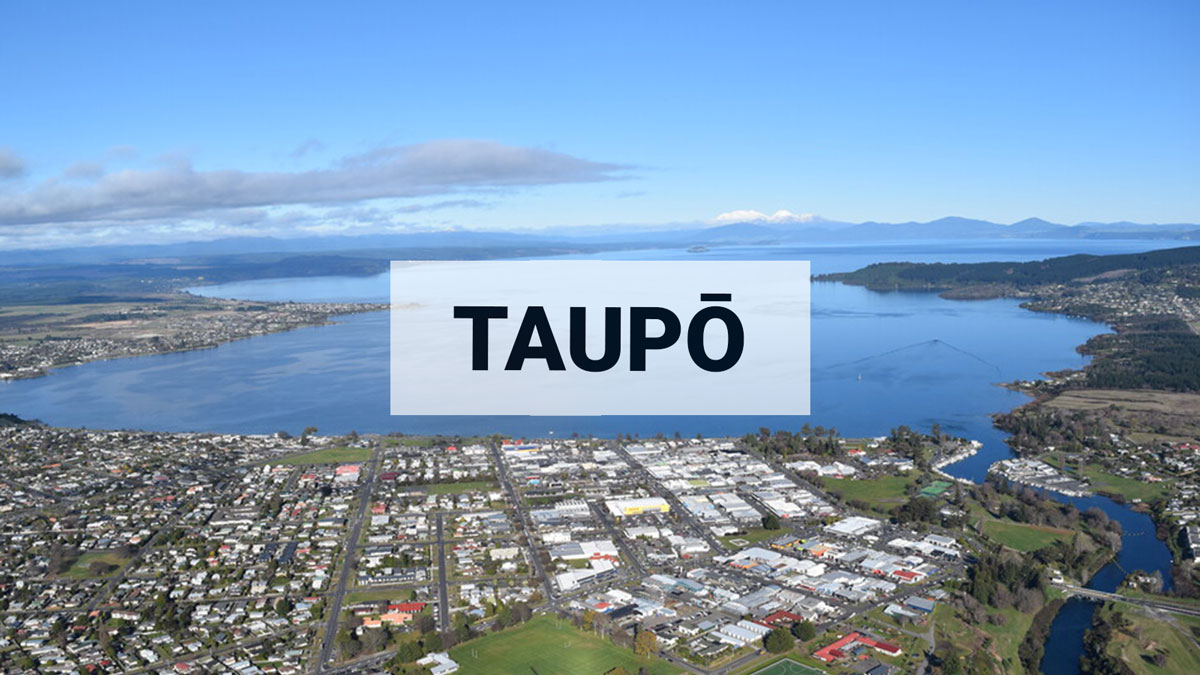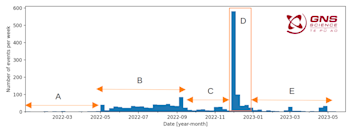
Volcanic activity at Taupō Volcano is now back to background levels. The Volcanic Alert Level is lowered to Level 0.
Monitoring at Taupō Volcano shows that both ground deformation and earthquake activity have continued to decrease over the past few weeks. These monitoring data indicate the level of unrest has now returned to what is normally seen as the background. The Volcanic Alert Level is now lowered to Level 0 for Taupō Volcano.
This latest episode of unrest at Taupō volcano started in May 2022. The Volcanic Alert Level for Taupō volcano was raised to 1 in September 2022 in response to this activity, indicating minor unrest was occurring. This unrest has now paused. We have recorded both ground deformation signals and shallow earthquakes under the central lake area during this period.
Through early 2023 (January to April) earthquake activity has continued with ground deformation. However, both were showing declines. These have returned to typical background levels in May 2023. A combination of magma movement at depth, faults slipping, and hydrothermal fluids has likely been driving the earthquakes and ground deformation observed this last year. This activity has now paused.
We have seen several processes at play during the volcanic unrest over the last year at Taupō Volcano. In the initial phase starting in early May 2022, we saw an increase in the number of earthquakes per month and by June there was an indication of uplift at Horomatangi Reef in the lake. By September both trends were well established with the monthly number of earthquakes ranging between 20 and 90 per month (Fig. 1). Our GNSS (GPS) instruments around the lake recorded outward movement around the lake and Horomatangi Reef showed some uplift at a rate of 60 ± 20 mm per year. These were within our expectations for Taupō volcano at Volcanic Alert Level 1. Between September and November 2022 earthquake activity slowed down.
On 30 November 2022 a Magnitude 5.7 event occurred at 9 km depth. This earthquake was widely felt and accompanied by significant ground movement at Horomatangi Reef. We measured 180 mm (18 cm) of uplift and a shift to the southeast of 160 mm (16 cm). This movement of the lakebed created a small tsunami in the lake while the ground shaking set off a submarine landslide near Wharewaka Point. This created a 2nd local tsunami that flooded the foreshore area. Aftershocks continued through to February 2023; over 820 were located. Another moderate sized earthquake occurred on 5 March (M4.4).
Overall, over the past year, there have been just over 1800 earthquakes under Taupō volcano, accompanied by some measurable - although too small to impact local communities - ground deformation of the lake floor and around the lake. Although this is the first time the VAL has been raised, this is not the first volcanic unrest at Taupō. It is the most recent of 18 historical unrest episodes in the past 150 years. Several of these were more severe than what we have observed over the last year. None of those episodes, or the many other episodes which would have occurred over the past 1800 years before written records were kept, ended in an eruption. The last eruption at Taupō volcano was in 232 AD ± 10 years. The chance of an eruption at Taupō remains very low in any one year.
What is happening now?
The current unrest episode has lasted for about 1 year. The rate of shallow earthquakes and the rate of ground deformation at the surface have now decreased to typical background levels. Based on the declines the Volcanic Alert Level is now lowered to level 0 for Taupō volcano, and the Aviation Colour Code remains at Green. Volcanic Alert Level 0 is mostly associated with environmental hazards. However, earthquake activity can and will still occur at background levels and at areas near to Taupō, such as around the geothermal systems and in the south and western ends of the lake. We continue to actively monitor the volcano and, when we have more information, will share this.
The Volcanic Alert Level reflects the current level of volcanic unrest or activity and is not a forecast of future activity. Further information about the Volcanic Alert Levels and what they mean can be found here. More information about caldera unrest can be accessed from this report.
Agnes Mazot
Duty Volcanologist
Media Contact: 021 574541 or media@gns.cri.nz
The Tūwharetoa Māori Trust Board (CEO Rakeipoho Taiaroa) is closely involved in discussions as the landowner of Lake Taupō. More information about the Trust can be found at https://www.tuwharetoa.co.nz/
We acknowledge the contribution of colleagues in the ECLIPSE research programme (www.supervolcanoes.nz) led by Te Herenga Waka – Victoria University of Wellington; in analysis and interpretation of some of the Taupō data during this unrest episode.
Although we can’t prevent natural hazards, we can prepare for them – and we should.
Know what warning signs to look out for, so you can act quickly. Drop, Cover, and Hold during a large earthquake. If it is Long or Strong, Get Gone! People near the lake front should move to higher ground as soon as it is safe to do so, especially if they hear loud noises or see unusual lake action during earthquake activity.
During volcanic activity, follow official advice provided by your local Civil Defence Emergency Management Group. More information about Civil Defence in the Taupō District can be found here.
For information on preparing for earthquakes or responding to volcanic activity, there are guidelines from the National Emergency Management Agency's (NEMA) Get Ready website.
Prepare your home. Protect your whānau.
There’s a lot we can do to make our homes safer and stronger for earthquakes. Toka Tū Ake EQC’s website has key steps to get you started.

